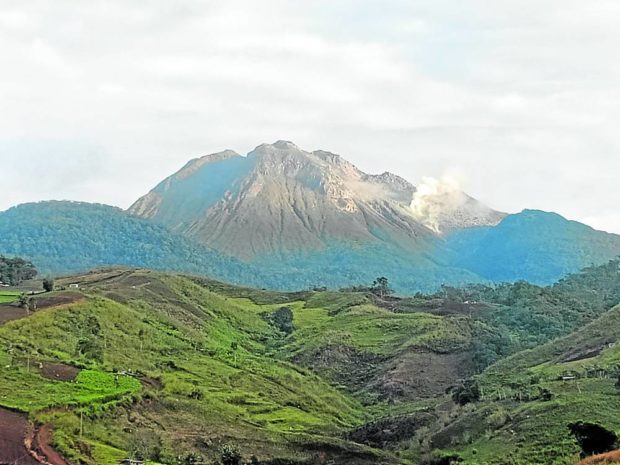Illegal structures also found on Davao’s Mt. Apo, reveals Sen. Raffy Tulfo

Mt. Apo, a protected area under the category of natural park, seen from Sitio Bagong Silang, Barangay Managa, Bansalan, Davao del Sur. (File photo by ORLANDO DINOY / Inquirer Mindanao)
MANILA, Philippines — No different from the saddening fate of Chocolate Hills in Bohol, Sen. Raffy Tulfo said business establishments have also been built on protected areas of Mt. Apo in Davao City.
In a privilege speech delivered Monday, Tulfo said he received numerous tips and reports of other tourist sites and protected areas that are not properly guarded by the Philippine government.
This came not long after Captain’s Peak Resort within the protected Chocolate Hills became viral.
READ: Binay on seeing resorts in Chocolate Hills: ‘Infuriating, heartbreaking’
Article continues after this advertisementREAD: DENR: Closure order vs resort near Chocolate Hills issued Sept. 2023
Article continues after this advertisementAlarmed
“I was alarmed when a mountaineering group called my attention to what was happening in Mt. Apo. From the tiny hills in Bohol, I want to go to Mt. Apo of Davao. According to them, many resorts are also located in Mt. Apo National Reserve on the Digos side — this is said to be Twin Mountain View Resort, MonteFrio Resort, and Villa Recurso. They are already out of the buffer zone, if the basis is what we found on Google Earth and comparing it with the map of Mt. Apo,” said Tulfo in a mix of English and Filipino.
The senator said he is personally concerned about the development citing President Ferdinand “Bongbong” Marcos Jr.’s earlier directive to preserve Mt. Apo as “it vies for its inclusion in the United Nations Educational, Scientific and Cultural Organization [Unesco] list of World Heritage Sites.”
“This statement of the President [Marcos] was sometime in October 2023, and because of this, it seems that the seats of the PAMB or Protected Area Management Board of Mt. Apo were set on fire. By November 2023, they immediately called a meeting to take action against illegal structures without permits in the Multiple Use Zones of Mt. Apo and look into decline in the forest cover. But my question is, how did these illegal structures get through?” he said.
Two-year phaseout on Mt. Apo
According to Tulfo, his office contacted PAMB Chairperson Mercedes Dumagan assured them that there was an existing action plan to “phase out in two years” the illegal structures and occupants within the mountain’s Strict Protection Zone.
This, however, did not sit well with Tulfo, who wondered why PAMB should be given a two-year phasing period.
Apart from business establishments, illegal mining operations and illegal cutting of hardwood trees were also observed inside the Mt. Apo Protected Area. Tulfo said these operations were pushed by “local officials protected by soldiers.”
“They are doing this to put up a banana plantation. Many more problems are plaguing Mt. Apo, such as land conversion for settlements, water pollution, introduction of foreign exotic species, presence of large communities, increasing population, destructive and inappropriate livelihood, and poverty in the area,” he added.
Quarrying, mining in Zambales
Meanwhile, in the municipalities of San Marcelino, San Narciso, and San Felipe in Zambales, Tulfo said seabed quarrying and onshore black sand mining are ongoing.
READ: Chinese dredging ships alarm Zambales residents
“This coastal area in Zambales is the source of livelihood for those who harvest bangus fish fry. They earn P5,000 [to] P13,000 per day. But now it is in danger because of quarrying and black sand mining,” he said.
For Tulfo, the problem lies in the provision of an Environmental Compliance Certificate (ECC) “without the conduct of site visits or verification of data on the ground or to fact-check with local stakeholders.”
This prompted the senator to question why government agencies take no responsibility and eventually opt to blame one another for the consequences of their actions.
“Instead of ensuring that these areas are protected, everyone is just pointing fingers at each other on who is at fault. The [local government unit] points to the [Department of Environment and Natural Resources], saying that it issued the ECC. The DENR blames the LGU for issuing the business permit. PAMB says it’s the indigenous peoples fault because they manage the ancestral lands. And the Indigenous Peoples are pointing at PAMB, which they claim are not consulting them,” said Tulfo.
Later in the session, Tulfo’s privilege speech was referred to the committees on environment, natural resources and climate change and local government.